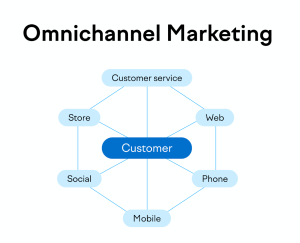Omnichannel Messaging – Everything You Need to Know

If you’re an entrepreneur and struggling to maintain your content and tasks across different applications, then this blog is for you. In this blog we’re exploring Omnichannel Messaging and why it’s the key to establishing strong relationships with customers and advancing your business.
A 2019 Omnisend study found that omnichannel campaigns saw an 18.96% engagement rate, while single-channel saw just a 5.4% engagement rate. The typical customer now uses six interactions—triple the number of interactions they used to make on a single purchase.
90% of customers expect their interactions to be consistent across all channels. They assume that the promo code they saw on Instagram will be valid when used on the website or in the store. They believe that if they sign up for the store membership, they’re going to avail the membership discounts across the country’s store chains.
88% of Generation Z (GenZ) say that they want brand experiences among digital and physical channels. More than half (54%) of the group said social media is the top influence channel, ahead of websites.
Consumer expectations continue to push brands to improve consistency and seamlessness across all channels. Omnichannel messaging is proving to be a foundational strategy in this ever-evolving era.
What is Omnichannel Messaging?
Omnichannel messaging is defined as providing a unified customer experience through all communication channels such as email, SMS, social media (WhatsApp, Facebook Messenger), and live chat. It allows you to reach a customer wherever they are.
With omnichannel messaging, customers get tailored and unique experiences without having to repeat themselves. Chatbots and CRMs ensure that consumer data remains aligned so that agents can rapidly resume conversations with personalized support. The idea behind employing omnichannel communication is to achieve higher-order values, more delighted clientele, and stronger brand affinity.
How Does It Work?
Omnichannel Messaging keeps the conversation flowing smoothly as customers transition between platforms. This results in loyal customers, fewer misunderstandings, and faster conflict-resolution.
In omnichannel messaging platforms, APIs ensure that communications can be sent or received from one central dashboard by integrating your existing systems. This integration will help you monitor customer interactions across different channels; giving you insights into their behaviour and preferences.
What should I look for in an omnichannel messaging platform?
When choosing an omnichannel messaging platform, consider the following features:
Multiple Channel Integration: The framework should be able to communicate on different channels such as SMS, social media, live chat, and VoIP in order to create a consistent customer experience across multiple channels.
Seamless Customer Journeys: Customers should be able to move from one channel to another without repeating information. Also, it must have the ability to personalize messages to suit your clients’ unique needs and desires. Thus, ensuring a smooth flow of their interaction with the company.
Data Insights & Protection: The platform must give an insight into its customer behaviour, and offer strong data protection and encryption to ensure the security of client data.
User-Friendly Interface: Your team should be able to understand & comprehend the platform’s interface and how it operates so that they can easily control the interplay between customers.
Scalability: The platform must be flexible and adapt itself to any workflow and pace. This enables it to expand alongside your business.
Integrations: The platform should link up with CRM systems and other business applications. With an open API or pre-built connections, your workflows can run smoother and more efficient.
Automated Technical Support: The platform should provide technical expert guidance and support through chatbots so that you’ve all the resources required to make the best use of the system.

How to Create an Omnichannel Messaging Strategy
To create an effective omnichannel messaging strategy, follow these key steps:
Understand your customers: Research about your customers’ preferences, behaviour patterns, and pain points. Determine who is your target audiences as well as their preferred messaging channels.
Map Customer Journey: Mapping the customer journey from awareness to purchase will identify areas where an omnichannel experience can be implemented such as live chat, pop-ups on web pages where you tend to lose customers.
Scale channel to different screens: As more and more internet browsing searches and purchases are carried out on mobiles, not making your channel mobile-friendly is the easiest way to fail.
Develop a consistent brand voice: Keep a constant tone in the company’s all communication channels, hence ensuring that your messaging is clear and consistent. Have an identical brand language in every channel to facilitate recognition and sustain the company’s image.
Centralize customer support within a CRM system: Customer support from every channel should be combined into one platform under a CRM system whether the customer is browsing your website, social media pages, or mobile app. Customers should be able to contact you without leaving that channel.
Continue omnichannel post-sale: This is where most companies slip-up. For ex: Joe buys a pair of shoes online but they don’t fit. He wants to return it and needs a refund. A smooth return and refund process will make Joe loyal to the brand.
Include your physical store: If you’ve a physical store, make sure to include it in your omni-channel strategy. For ex: Allowing customers to return an online purchase in store and enabling them to place orders through the app if the item is out of stock at the store.

What are some of the use cases of omnichannel messaging?
Omnichannel messaging offers various use cases to improve customer engagement, contentment, and conversions. Some examples include:
Retail: Omnichannel strategies can ensure that customers have a homogenous shopping experience, whether they’re purchasing from their mobile device online, using a desktop computer, or going to physical stores. Retailers can make use of various channels like SMS, email, mobile apps, and social media to send personalized offers, recommendations on products, and reminders on shopping carts.
Healthcare: Simplify the patient journey by integrating appointment scheduling, reminders, health advice, telemedicine services across multiple communication channels.
Banking: Omnichannel enables a seamless transition between online banking; mobile apps and physical branches. Customers would receive account updates via SMS, start an application for a loan online, and complete it in the branch.
Customer service: Customer service teams may utilize an omnichannel messaging system that provides real-time assistance across many platforms. A customer could initiate a chat with customer service on a website and then move to a phone call without loss of context.
Brick-and-mortar stores: Engaging with customers during their online and offline movements, sharing follow-up marketing materials that are relevant to their past purchase.
Incorporating omnichannel messaging will benefit companies to leverage its expertise, know-how, and support for better customer satisfaction and expansion initiatives.




